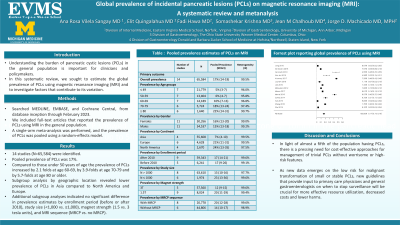Tuesday Poster Session
Category: Biliary/Pancreas
P2850 - Global Prevalence of Incidental Pancreatic Lesions on Magnetic Resonance Imaging: A Systematic Review and Meta-Analysis
Tuesday, October 24, 2023
10:30 AM - 4:00 PM PT
Location: Exhibit Hall

Has Audio

Ana Vilela, MD
Eastern Virginia Medical School
Norfolk, VA
Presenting Author(s)
Ana Rosa Vilela Sangay, MD1, Elit Quingalahua, MD2, Fadi Hawa, MD2, Somashekar Krishna, MD3, Jean M. Chalhoub, MD4, Jorge D. Machicado, MD, PhD2
1Eastern Virginia Medical School, Norfolk, VA; 2University of Michigan, Ann Arbor, MI; 3The Ohio State Wexner Medical Center, Columbus, OH; 4Staten Island University, Northwell Health, Staten Island, NY
Introduction: Understanding the burden of PCLs in the general population is important for clinicians and policymakers. Among non-invasive imaging modalities, MRI has shown high sensitivity in detecting PCLs, making it an ideal tool for estimating the prevalence of PCLs. In this systematic review, we sought to estimate the global prevalence of PCLs using MRI and to investigate potential factors that may contribute to the variation in prevalence rates.
Methods: A medical librarian conducted a comprehensive search of MEDLINE, EMBASE, Cochrane Central, and Scopus, from database inception through February 2023. We included full-text articles that reported the prevalence of PCLs using MRI in the general population. Prospective, retrospective, and cross-sectional studies with a sample size of at least 100 individuals were included. All studies that exclusively used CT were excluded. Two independent reviewers selected studies, extracted data, and assessed risk of bias. A single-arm meta-analysis was performed, and the prevalence of PCLs was pooled using a random-effects model. Subgroup analyses were performed.
Results: Among 14 studies encompassing 65,584 subjects, the pooled prevalence of PCLs on MRI was 17% (95%CI 14-19; I2 99%). There was no significant difference in the prevalence of PCLs between men and women. Prevalence of PCLs in subjects aged 49 or less was 5% (95%CI 3-7%; I2 96%). Compared to those under 50 years of age, the prevalence of PCLs increased by two-folds at age 60-69, (OR 2.07; 95%CI 1.26-3.43; I2 88%), by four-folds at age 70-79 (OR 3.90; 95% CI 1.95-7.80; I2 93%), and by six-folds at age 80 or older (OR 5.70; 95%CI 2.57-12.66; I2 90%) (Table 1). Subgroup analysis by geographic location revealed lower prevalence of PCLs in Asia (7%; 95%CI 4-10; I2 99%) compared to North America (24%; 95%CI 14-35; I2 97%) and Europe (21%; 95% CI 11-31; I2 99%). Additional subgroup analyses indicated no significant difference in prevalence estimates by enrollment period (before or after 2010), study size (< 1,000 vs. ≥1,000), magnet strength (1.5 vs. 3 tesla units), and MRI sequence (MRCP vs. no MRCP).
Discussion: The global prevalence of PCLs on MRIs is estimated to be 17%, which is almost double the previous estimates obtained using any type of imaging (8%). Prevalence of PCLs varies by age and geographic location. Within the last two decades, the prevalence of PCLs on MRIs is overall stable accounting for variations in time trends and MRI technology.
Disclosures:
Ana Rosa Vilela Sangay, MD1, Elit Quingalahua, MD2, Fadi Hawa, MD2, Somashekar Krishna, MD3, Jean M. Chalhoub, MD4, Jorge D. Machicado, MD, PhD2. P2850 - Global Prevalence of Incidental Pancreatic Lesions on Magnetic Resonance Imaging: A Systematic Review and Meta-Analysis, ACG 2023 Annual Scientific Meeting Abstracts. Vancouver, BC, Canada: American College of Gastroenterology.
1Eastern Virginia Medical School, Norfolk, VA; 2University of Michigan, Ann Arbor, MI; 3The Ohio State Wexner Medical Center, Columbus, OH; 4Staten Island University, Northwell Health, Staten Island, NY
Introduction: Understanding the burden of PCLs in the general population is important for clinicians and policymakers. Among non-invasive imaging modalities, MRI has shown high sensitivity in detecting PCLs, making it an ideal tool for estimating the prevalence of PCLs. In this systematic review, we sought to estimate the global prevalence of PCLs using MRI and to investigate potential factors that may contribute to the variation in prevalence rates.
Methods: A medical librarian conducted a comprehensive search of MEDLINE, EMBASE, Cochrane Central, and Scopus, from database inception through February 2023. We included full-text articles that reported the prevalence of PCLs using MRI in the general population. Prospective, retrospective, and cross-sectional studies with a sample size of at least 100 individuals were included. All studies that exclusively used CT were excluded. Two independent reviewers selected studies, extracted data, and assessed risk of bias. A single-arm meta-analysis was performed, and the prevalence of PCLs was pooled using a random-effects model. Subgroup analyses were performed.
Results: Among 14 studies encompassing 65,584 subjects, the pooled prevalence of PCLs on MRI was 17% (95%CI 14-19; I2 99%). There was no significant difference in the prevalence of PCLs between men and women. Prevalence of PCLs in subjects aged 49 or less was 5% (95%CI 3-7%; I2 96%). Compared to those under 50 years of age, the prevalence of PCLs increased by two-folds at age 60-69, (OR 2.07; 95%CI 1.26-3.43; I2 88%), by four-folds at age 70-79 (OR 3.90; 95% CI 1.95-7.80; I2 93%), and by six-folds at age 80 or older (OR 5.70; 95%CI 2.57-12.66; I2 90%) (Table 1). Subgroup analysis by geographic location revealed lower prevalence of PCLs in Asia (7%; 95%CI 4-10; I2 99%) compared to North America (24%; 95%CI 14-35; I2 97%) and Europe (21%; 95% CI 11-31; I2 99%). Additional subgroup analyses indicated no significant difference in prevalence estimates by enrollment period (before or after 2010), study size (< 1,000 vs. ≥1,000), magnet strength (1.5 vs. 3 tesla units), and MRI sequence (MRCP vs. no MRCP).
Discussion: The global prevalence of PCLs on MRIs is estimated to be 17%, which is almost double the previous estimates obtained using any type of imaging (8%). Prevalence of PCLs varies by age and geographic location. Within the last two decades, the prevalence of PCLs on MRIs is overall stable accounting for variations in time trends and MRI technology.
Disclosures:
Ana Rosa Vilela Sangay indicated no relevant financial relationships.
Elit Quingalahua indicated no relevant financial relationships.
Fadi Hawa indicated no relevant financial relationships.
Somashekar Krishna: Mauna Kea Technologies – Grant/Research Support. Taewoong Medical USA – Grant/Research Support. US Biotest – Grant/Research Support.
Jean M. Chalhoub indicated no relevant financial relationships.
Jorge Machicado indicated no relevant financial relationships.
Ana Rosa Vilela Sangay, MD1, Elit Quingalahua, MD2, Fadi Hawa, MD2, Somashekar Krishna, MD3, Jean M. Chalhoub, MD4, Jorge D. Machicado, MD, PhD2. P2850 - Global Prevalence of Incidental Pancreatic Lesions on Magnetic Resonance Imaging: A Systematic Review and Meta-Analysis, ACG 2023 Annual Scientific Meeting Abstracts. Vancouver, BC, Canada: American College of Gastroenterology.
